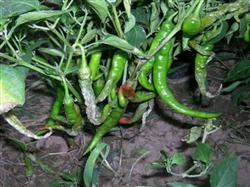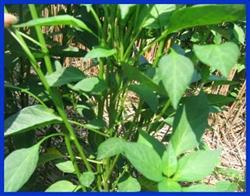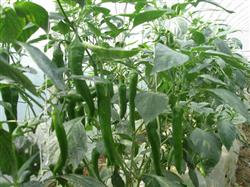Field Management techniques of Spring Pepper

(1) the field shall irrigate the soil moisture at the bottom before planting. Apply 5000 kg of high-quality mature organic fertilizer, 200kg of cake fertilizer or 1000 kg of chicken manure, 50 kg of ammonium bicarbonate, 50 kg of calcium superphosphate, 20 kg of potassium sulfate and 20 kg of micro-fertilizer per mu. (2) ridging and film-laying in the field will be 0.85 meters wide and 0.1 meters high, with a ridge interval of 0.35 meters. Ridging should be flat and straight to facilitate film laying. Spread 0.9 meters of plastic film, the distance between the films is 0.3 meters. (3) planting in the field in the middle and last ten days of April, that is, after the late frost, planting in the field. Conditional farmers can use a small amount of active potash fertilizer per plant to ensure the normal growth of pepper seedlings. When planting, do not use steel brazing to prevent compacting the soil, which is disadvantageous to the root growth of seedlings. (4) after the field management was planted, it was the period of temperature change, and the pepper was in the slow seedling stage and weak growth stage. At this time, we should pay attention to the harm of aphids and diseases, spray the mixture of imidacloprid, carbendazim and ribavirin, at the same time, ensure the humidity in the field, promote the early development and rapid growth, and ensure that the pepper passes the critical period of slow seedling. (5) the basic principle of reasonable topdressing of pepper is "controlling nitrogen, stabilizing phosphorus and supplying potassium". The details are as follows: 1. Light application of seedling fertilizer: at this stage, the effect of fertilization is to promote the robust growth of planted seedlings and lay a good foundation for flowering and fruiting. During this period, compound fertilizer was the main topdressing. 2. Stable application of primary fruit fertilizer: at this stage, from flowering to the first harvest, the main function of fertilization is to promote pepper plant branching, flowering and fruit setting. Topdressing is mainly composed of nitrogen, phosphorus and potassium compound fertilizer, with 25 kg per mu, and 5 kg boron fertilizer can be applied per mu to improve the fruit setting rate. 3. The re-application of fruit fertilizer to pepper entered the peak fruiting period, which was the period of the maximum fertilizer requirement in the whole growing period. Fertilization is mainly nitrogen, phosphorus, potassium compound fertilizer, 30Mu 40kg per mu, an appropriate amount of potassium fertilizer, about 10kg per mu, combined with the use of a certain amount of micro-fertilizer. In general, after each topdressing, the pepper should be watered in time to promote the absorption of nutrients and improve the utilization rate of fertilizer. At the same time, it can also increase the humidity in the field, which is beneficial to flowering and fruit setting. 4. Fertilization in the later stage: spraying method can be used for extra-root topdressing in the later stage. Urea, potassium dihydrogen phosphate and other micro-fertilizers can be used specifically. (6) Film breaking in mid-tillage in the middle stage of pepper growth, soil consolidation and soil moisture damage are easy to be caused by watering, fertilization, rainfall and other agricultural operations, so ploughing should be done in time before ridging to promote root growth in depth and prevent premature senescence. The depth and scope of intertillage shall be subject to no damage to the root system. Generally speaking, timely watering after ploughing and soil cultivation is beneficial to the growth of hot pepper. The field management of pepper during the whole growth period is good, the plant growth is robust, the stress resistance of pepper is relatively enhanced, and the disease harm is mild, which can reduce the times of drug use, reduce the production cost, increase the yield and improve the quality of pepper. (7) the prevention and control of pepper pests are mainly aphids, cotton bollworm and Plutella xylostella, and the diseases are Fusarium wilt, Fusarium wilt, anthracnose, bacterial wilt, scab, virus and blight. Aphids are the transmission media of virus diseases. We should pay attention to the control of aphids. Imidacloprid or pyrethroid pesticides can be used to control cotton bollworm and Plutella xylostella. Fusarium wilt, Fusarium wilt, blight and anthracnose are fungal diseases, which can be sprayed with carbendazim, methyl topiramate and carbendazim. Bacterial wilt and scab are bacterial diseases, which can be controlled by streptomycin and neophytomycin. Virus disease is caused by virus, so we should take the control of aphids and diseases as the main means, and we can spray phytovirin and virulent to control the disease. Generally speaking, pest control should be carried out as early as possible, and disease prevention should be based on prevention. before the disease occurs, combined with the control of aphids with a small amount of carbendazim, chlorothalonil or methyl topiramate can effectively control the occurrence of the virus and achieve the purpose of disease prevention and pest control.
- Prev

High-yield cultivation techniques of Capsicum in Spring, Summer and Autumn in greenhouse
At present, the main problems in production are mainly production in early spring, less production in autumn after removal of plastic film in summer, listing of vegetables in open field after summer, relaxed management, and low yield of pepper in the later stage. In order to maximize the production role of greenhouse facilities, the author guides the masses to carry out a big stubble planting in spring, summer and autumn.
- Next

Management of Pepper after planting in greenhouse in Spring
Pepper in greenhouse in early spring is generally planted from mid-February to early March, and then poured enough bottom water, water seepage is divided into several times, sealing holes, and the planting mouth of plastic film is sealed. At this time, we should pay attention to the following three management work: after timely temperature control, ventilation and planting, the temperature outside the shed is still low, pay attention to heat preservation, and keep the temperature at 22-30 ℃ during the day.
Related
- Where is it suitable to grow horseradish in China? it is expected to see the middle altitude horseradish in Alishan.
- How to prevent tomato virus disease reasonably? (Control methods included)
- Many people like to plant towel gourd on the balcony. What are the main points of this method and management?
- What crops can chili peppers be mixed with?
- Fertilization techniques and matters needing attention in Tomato
- What are the grafting techniques for peach seedlings in spring?
- Harm and control methods of root swelling disease of Chinese cabbage
- What are the pests of sweet potatoes? How to prevent and cure it?
- Symptoms, causes and Control methods of navel Rot in Tomato
- The cause of "Cucumber rotten bibcock" in Farmers' planting Cucumber and its Control Plan

